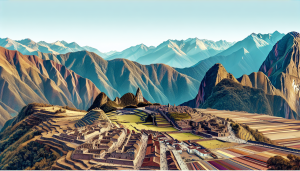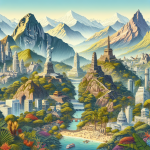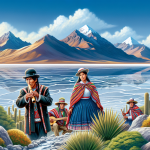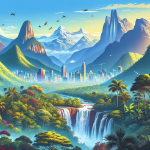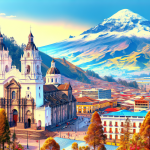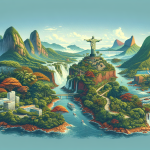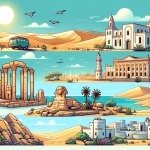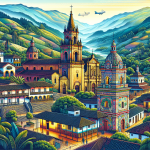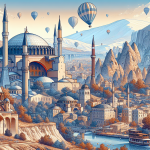Peru: A Journey Through History, Culture, and Nature
Peru, a land of ancient civilizations, diverse ecosystems, and vibrant cultures, stands as one of South America’s most fascinating destinations. From the arid coastal plains to the soaring peaks of the Andes, and the lush expanses of the Amazon rainforest, Peru offers a multitude of experiences that cater to every type of traveler. Whether you’re a history buff eager to explore the ruins of Machu Picchu, an adventurer seeking the thrill of trekking the Inca Trail, or a nature lover drawn to the biodiversity of the Amazon, Peru promises an unforgettable journey. This comprehensive guide will delve into the rich tapestry of Peru’s offerings, highlighting the must-see attractions, the unique cultural practices, and the natural wonders that make it a top travel destination. Join us as we explore the best that Peru has to offer, ensuring that your trip is packed with memorable experiences and insightful discoveries.
Historical Landmarks and Ancient Ruins
Machu Picchu: The Crown Jewel of Peru
Machu Picchu is, without a doubt, the most iconic symbol of Peru. This ancient Incan citadel, perched high in the Andes Mountains, has fascinated historians, archaeologists, and travelers for decades. Discovered in 1911 by Hiram Bingham, Machu Picchu is a testament to the ingenuity of the Inca civilization. The site comprises several well-preserved ruins, including temples, terraces, and living quarters, all built using sophisticated engineering techniques. Visiting Machu Picchu is a must for anyone traveling to Peru, and the experience is even more rewarding when you hike the Inca Trail, a challenging yet breathtaking route that takes you through various ecosystems and past other Incan ruins before culminating at the Sun Gate, where you get your first glimpse of Machu Picchu.
The Sacred Valley: A Historical Treasure Trove
The Sacred Valley, located near Cusco, was once the heart of the Inca Empire. This fertile valley is home to a number of significant archaeological sites, including Pisac, Ollantaytambo, and Chinchero. Each of these sites offers a unique glimpse into the history and culture of the Incas. Pisac is famous for its impressive agricultural terraces and vibrant market, while Ollantaytambo boasts an ancient fortress that played a crucial role in the resistance against Spanish conquest. Chinchero, known for its traditional weaving techniques, provides a cultural experience that complements the historical exploration. A visit to the Sacred Valley is an excellent way to deepen your understanding of the Inca civilization and its enduring legacy.
Cusco: The Historical Capital
Cusco, often referred to as the historical capital of Peru, serves as the gateway to the Sacred Valley and Machu Picchu. This UNESCO World Heritage site is a living museum, blending Incan and Spanish colonial architecture. The city’s main square, Plaza de Armas, is surrounded by stunning buildings, including the Cusco Cathedral and the Church of La Compañía. Sacsayhuamán, a massive Incan fortress overlooking the city, offers panoramic views and a glimpse into the architectural prowess of the Incas. Cusco’s rich history and vibrant culture make it an essential stop on any Peruvian itinerary.
Natural Wonders and Outdoor Adventures
The Amazon Rainforest: A Biodiversity Hotspot
Covering over 60% of Peru, the Amazon rainforest is one of the most biodiverse regions on the planet. The Peruvian Amazon offers a unique opportunity to explore this vibrant ecosystem, home to countless species of plants, animals, and insects. Manu National Park and Tambopata National Reserve are two of the best places to experience the Amazon’s wonders. Activities such as guided jungle treks, boat rides along the Amazon River, and wildlife spotting tours provide a deeper understanding of this incredible environment. Staying in eco-lodges allows you to immerse yourself in the rainforest while supporting sustainable tourism practices.
The Andes Mountains: A Trekker’s Paradise
The Andes Mountains, stretching across the western edge of South America, are a defining feature of Peru’s landscape. This mountain range offers numerous trekking opportunities, each providing stunning views and unique challenges. The Inca Trail is the most famous trek, but there are other equally rewarding routes, such as the Salkantay Trek and the Ausangate Trek. These treks take you through diverse terrains, from snow-capped peaks and high-altitude passes to lush valleys and remote villages. The Andes are also home to several high-altitude lakes, including Lake Titicaca, the highest navigable lake in the world. A visit to the floating islands of Uros on Lake Titicaca offers a fascinating glimpse into the lives of the indigenous communities who have lived there for centuries.
Cultural Experiences and Local Traditions
Lima: The Culinary Capital
Lima, the capital of Peru, is renowned for its culinary scene. The city’s diverse cuisine is a reflection of its multicultural heritage, blending indigenous, Spanish, African, and Asian influences. Lima’s food markets, such as Mercado de Surquillo, offer a chance to sample local ingredients and traditional dishes. The city’s top restaurants, including Central, Maido, and Astrid y Gastón, have gained international acclaim for their innovative approaches to Peruvian cuisine. A culinary tour of Lima is a must for food enthusiasts, providing an opportunity to taste everything from ceviche and anticuchos to pisco sours and chicha morada.
Traditional Festivals and Celebrations
Peru’s cultural calendar is filled with vibrant festivals and celebrations that offer a glimpse into the country’s rich traditions. Inti Raymi, the Festival of the Sun, is one of the most important Incan festivals, celebrated annually in Cusco on June 24th. This event includes elaborate reenactments of Incan rituals, colorful parades, and traditional music and dance. Another notable festival is the Qoyllur Rit’i, held in the high Andes near Cusco, which combines indigenous and Catholic traditions in a pilgrimage to a sacred mountain. The Fiesta de la Virgen de la Candelaria in Puno is another highlight, featuring lively processions, music, and dance performances that showcase the cultural heritage of the Andean region.
Handicrafts and Artisanal Markets
Peru’s rich artistic traditions are evident in its handicrafts and artisanal markets. The country’s diverse regions produce a wide range of handmade goods, from intricate textiles and ceramics to silver jewelry and wood carvings. The markets in Cusco, Pisac, and Lima are excellent places to find unique souvenirs and support local artisans. The traditional weaving techniques of the Andean communities, passed down through generations, are particularly noteworthy. Visitors can often observe these techniques in action and even participate in workshops to learn more about the craft.
Practical Tips for Traveling in Peru
When to Visit
Peru’s diverse geography means that the best time to visit can vary depending on the region. The dry season, from May to September, is generally the best time to visit the Andes and Machu Picchu, as the weather is more predictable and the skies are clearer. The Amazon rainforest is hot and humid year-round, but the dry season (June to October) is ideal for wildlife spotting and jungle treks. Coastal regions, including Lima, experience mild temperatures throughout the year, but the summer months (December to March) offer the best beach weather.
Health and Safety
When traveling to Peru, it’s essential to take certain health and safety precautions. Altitude sickness can be a concern in high-altitude areas such as Cusco and Machu Picchu. It’s advisable to spend a few days acclimatizing before undertaking strenuous activities. Drinking plenty of water, avoiding alcohol, and taking it easy can help mitigate the effects of altitude sickness. In the Amazon, insect repellent and protective clothing are crucial to prevent mosquito bites and reduce the risk of diseases such as malaria and dengue fever. It’s also a good idea to consult with a healthcare provider about recommended vaccinations for Peru.
Transportation and Getting Around
Peru has a well-developed transportation network, making it relatively easy to get around. Domestic flights are the quickest way to cover long distances, with major airlines such as LATAM and Avianca offering frequent services between cities. Buses are a popular and economical option for shorter distances, with companies like Cruz del Sur and Oltursa providing comfortable and reliable services. In cities, taxis and ridesharing apps are convenient for getting around, but it’s essential to use reputable companies and agree on fares in advance to avoid any surprises. For those who prefer a more adventurous approach, renting a car or joining guided tours are also viable options.
Conclusion
Peru is a destination that offers something for everyone, from history enthusiasts and adventure seekers to nature lovers and culture aficionados. Its rich tapestry of ancient ruins, diverse ecosystems, and vibrant traditions make it a place that captivates the imagination and leaves a lasting impression. Whether you’re exploring the mystical ruins of Machu Picchu, trekking through the breathtaking landscapes of the Andes, or immersing yourself in the cultural vibrancy of Lima, Peru promises a journey filled with unforgettable experiences and discoveries. As you plan your trip to this remarkable country, keep these insights and tips in mind to ensure a smooth and enriching travel experience. Peru is not just a destination; it’s an adventure that beckons you to explore its wonders and embrace its magic.
